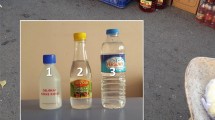Abstract
Objectives
To evaluate children who ingested corrosive substances, in terms of demographic features, nature of ingested substances, clinical findings, management and complications.
Methods
A total of 1709 cases aged between 0 and 16 y who ingested corrosive substance were analyzed retrospectively by evaluating the medical records of the patients.
Results
The mean age of the cases was 35.23 ± 30.65 mo and male:female ratio was 1.45. Forty one percent of corrosive substances causing intoxication contained NaOH. Thirty percent of the families consisted of 5 or more members. Fourteen percent of the mothers were illiterate. Stricture formation was observed in 29 (1.69 %) of the cases during follow-up. In 79.31 % of those cases alkaline substance ingestion was responsible for stricture development. It was found that stricture formation occurred more frequently among cases who were older than 5 y of age and this finding was statistically significant (p = 0.001).
Conclusions
The cases older than 5 y of age with the diagnosis of grade 2b esophagitis must be followed up closely for the stricture formation. In order to protect children from corrosive ingestion, importance must be given to preventive measures such as education of families, keeping and storing these agents out of the reach of children and providing safety caps for these products.


Similar content being viewed by others
References
Guven A. Dangers to children at home: Corrosive esophageal burn. TAF Prev Med Bull. 2008;7:535–40.
Oner N, Inan M, Vatansever U, Turan C, Celtik C, Kucukugurlu Y, et al. Poisoning in children living in Trakya region. Turk Arch Pediatr. 2004;39:25–30.
Yafet-Aji D, Keskin S, İlter O. Review of poisoning cases followed in the pediatric emergency division of Istanbul University, Cerrahpasa Medical Faculty, Department of Paediatrics. Turk Arch Pediatr. 1998;33:148–53.
Kayaalp L, Odabasi G, Dogangun B, Cavusoglu P, Bolat N, Bakan M, et al. Corrosive esophagitis in children: Social and psychological aspect. Turk Arch Pediatr. 2006;41:24–30.
Kutlu T, Cullu FA, Erkan T, Aji O, Tumay GT. Our experience with corrosive substance ingestion in children. Turk Arch Pediatr. 1998;33:92–8.
Adam JS, Birck HG. Pediatric caustic ingestion. Ann Otol Rhinol Laryngol. 1982;91:656–8.
Gaudreault P, Parent M, McGuigan MA, Chicoine L, Lovejoy Jr FH. Predictability of esophageal injury from signs and symptoms: A study of caustic ingestion in 378 children. Pediatrics. 1983;71:767–70.
Moazam F, Talbert JL, Miller D, Mollitt DL. Caustic ingestion and its sequela in children. South Med J. 1987;80:187–90.
Aydinoglu H, Aygun AD, Gungor S, Turgut M, Dogan Y. Retrospective evaluation of 176 poisoning cases followed in Fırat University Faculty of Medicine. Turk Arch Pediatr. 2000;35:245–8.
Katrivanou A, Lekka NP, Beratis S. Psychopathology and behavioural trends of children with accidental poisoning. J Psychosom Res. 2004;57:95–101.
Baskin D, Urganci N, Abbasoğlu L, Alkim C, Yalçin M, Karadağ C, et al. A standardised protocol for the acute management of corrosive ingestion in children. Pediatr Surg Int. 2004;20:824–8.
Sarioglu-Buke A, Corduk N, Atesci F, Karabul M, Koltuksuz U. A different aspect of corrosive ingestion in children: Socio-demographic characteristics and effect of family functioning. Int J Pediatr Otorhinolaryngol. 2006;70:1791–8.
De Jong AL, Macdonald R, Ein S, Forte V, Turner A. Corrosive esophagitis in children: A 30-year review. Int J Pediatr Otorhinolaryngol. 2001;57:203–11.
Zargar SA, Kochhar R, Mehta S, Mehta SK. The role of fiberoptic endoscopy in the management of corrosive ingestion and modified endoscopic classification of burns. Gastrointest Endosc. 1991;37:165–9.
Doğan Y, Erkan T, Çullu Çokuğras F, Kutlu T. Caustic gastroesophageal lesions in childhood: An analysis of 473 cases. Clin Pediatr (Phila). 2006;45:435–8.
Ertekin C, Alimoglu O, Akyildiz H, Guloglu R, Taviloglu K. The results of caustic ingestion. Hepatogastroenterology. 2004;51:1397–400.
Cam H, Kıray E, Tastan Y, Taştan Y, Çerçi Özkan H. Review of poisoning cases followed in the paediatric emergency division of Istanbul University, Cerrahpasa Medical Faculty, Department of Paediatrics. Turk Arch Pediatr. 2003;38:233–9.
Yafet-Aji D, Ilter O. Childhood poisoning in Turkey. Turk Arch Pediatr. 1998;33:154–8.
Spitz L, Lakhoo K. Caustic ingestion. Arch Dis Child. 1993;68:157–8.
Ferry GD. Caustic ingestion. In: Wyllie R, Hyams JS, eds. Pediatric Gastrointestinal Diseases. Philadelphia: W.B. Saunders Company; 1993. pp. 337–41.
Einhorn A, Horton L, Altieri M, Ochsenschlager D, Klein B. Serious respiratory consequences of detergent ingestions in children. Pediatrics. 1989;84:472–4.
Moulin D, Bertrand JM, Buts JP, Nyakabasa M, Otte JB. Upper airway lesions in children after accidental ingestion of caustic substances. J Pediatr. 1985;106:408–10.
Friedman EM. Caustic ingestions and foreign bodies in the aerodigestive tract of children. Ped Clin N Am. 1989;36:1403–10.
Crain EF, Gershel JC, Mezay AP. Caustic ingestion. Symptoms as predictors of esophageal injury. Am J Dis Child. 1984;138:863–5.
Salzman M, O’Malley RN. Updates on the evaluation and management of caustic exposures. Emerg Med Clin North Am. 2007;25:459–76.
Roy CC, Silverman A, Alagille D. Esophageal burns and foreign bodies. Pediatric Clinical Gastroenterology. St Louis: Mosby-Year Book Inc; 1995. pp. 153–8.
Trabelsi M, Loukhil M, Boukthir S, Hammami A, Bennaceur B. Accidental ingestion of caustics in Tunisian children. Report of 125 cases. Pediatrie. 1990;45:801–5.
Arevalo-Silva C, Eliashar R, Wohlgelernter J, Elidan J, Gross M. Ingestion of caustic substances: A 15-year experience. Laryngoscope. 2006;116:1422–6.
Tiryaki T, Livanelioglu Z, Atayurt H. Early bougienage for relief of stricture formation following caustic esophageal burns. Pediatr Surg Int. 2005;21:78–80.
Erdogan E, Eroglu E, Tekant G, Yeker Y, Emir H, Sarimurat N, et al. Management of esophagogastric corrosive injuries in children. Eur J Pediatr Surg. 2003;13:289–93.
Huang YC, Ni YH, Lai HS, Chang MH. Corrosive esophagitis in children. Pediatr Surg Int. 2004;20:207–10.
Conflict of Interest
None.
Role of Funding Source
None.
Author information
Authors and Affiliations
Corresponding author
Rights and permissions
About this article
Cite this article
Urganci, N., Usta, M., Kalyoncu, D. et al. Corrosive Substance Ingestion in Children. Indian J Pediatr 81, 675–679 (2014). https://doi.org/10.1007/s12098-013-1170-0
Received:
Accepted:
Published:
Issue Date:
DOI: https://doi.org/10.1007/s12098-013-1170-0




